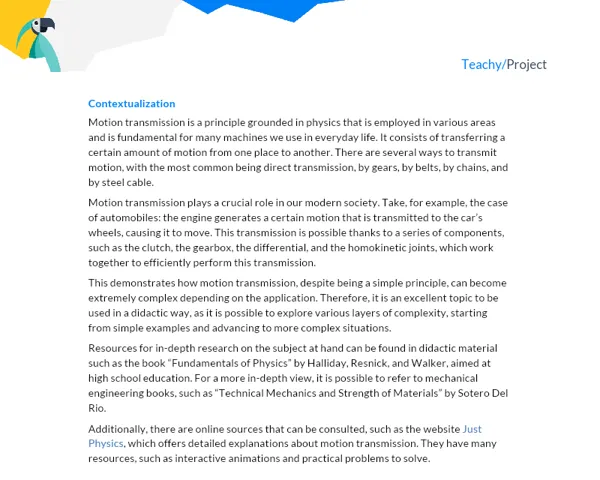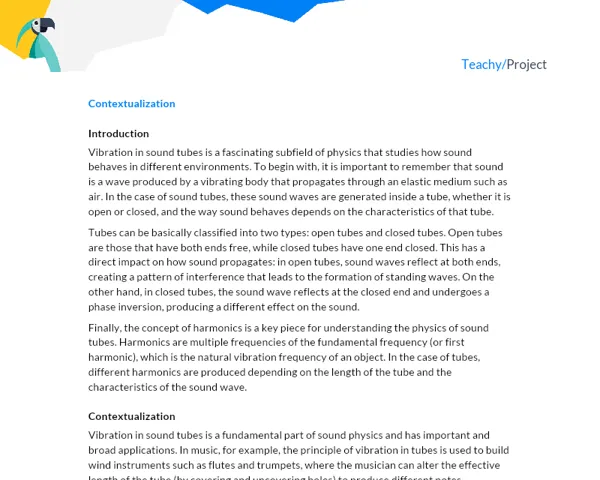Contextualization
Physics is a science that studies nature and its phenomena. Among its various areas of study, Mechanics is the one that seeks to understand and describe movements. The principles and laws that govern movement were first consolidated by Isaac Newton in the 17th century and are known as Newton's laws. They are the basis for understanding many of the physical phenomena that we observe in everyday life, from the simple act of walking to the complexity of planetary motions.
Mechanics is divided into several subareas, two of which are of great importance to us: Kinematics and Dynamics. Kinematics deals with the study of motion without worrying about its causes. Dynamics, in turn, focuses precisely on this point: it seeks to understand the causes of motion.
Newton's laws are three: the first law, also known as the law of inertia; the second law, which introduces us to the relationship between force, mass, and acceleration; and the third law, known as the law of action and reaction. These laws, despite having been formulated hundreds of years ago, are still used by scientists and engineers to solve problems and develop technologies.
Importance of the topic
Solving Mechanics problems, particularly those involving Newton's laws, is fundamental to our lives. From the way vehicles are designed to move on the roads to the operation of elevators and the flight of airplanes, everything is based on Newton's laws. In addition, concepts such as force, friction, mass, and acceleration are present in our daily lives, even if we don't realize it.
Understanding these laws and knowing how to apply them in solving physical problems is an essential skill for those who wish to pursue careers in science, technology, engineering, and mathematics. Moreover, knowledge of these laws allows us to better understand the world around us and make more informed decisions on a variety of issues, from choosing a car to assessing the impacts of human actions on the Earth's climate.
Hands-On Activity: Physics in Motion
Project Goal
The "Physics in Motion" project aims to challenge students to use concepts from Newton's laws to design and build a motorized race car using simple materials. In addition, students will have to apply measurement techniques to collect and analyze data on their car's performance. The group of students will also be challenged to integrate knowledge from another discipline, Mathematics, in the analysis and interpretation of the data collected.
Detailed project description
The project will be carried out by groups of 3 to 5 students and will last four weeks. In the first week, students will be introduced to the topic and begin studying selected mechanics topics and Newton's laws. During the second and third weeks, students will design and build their car. In the fourth week, students will test the car, collect and analyze data, and prepare a final report.
Each group will have to build a motorized race car using simple and low-cost materials. The car must be designed to travel a minimum distance of 5 meters on a flat and smooth surface. Students should use the concepts of Newton's laws in building their car, considering factors such as the car's mass, the force applied by the motor, the friction with the ground, and the inertia of motion.
Necessary materials
The following materials will be required:
- Building materials such as wood, metal, or plastic
- Small electric motors
- Basic tools such as pliers, screwdrivers, hammer, etc.
- Wires and battery
- Wheels
- Stopwatch
- Measuring tape
Detailed step-by-step for completing the activity
-
Concept study: Students should start by studying the theoretical concepts of Mechanics and Newton's Laws. They should understand how inertia, force, acceleration, and friction influence the motion of an object. They should learn how to calculate such values and how to interpret them.
- It is recommended that students use the indicated book and online resources for this step.
-
Project Outline: Students should develop a detailed outline of their car, indicating the materials they will use, the dimensions of the car, the location, and type of motor, the location of the wheels, among others.
-
Car Construction: With the outline finalized, groups should now start building the car. All members of the group must participate in this stage.
-
Testing and Data Collection: After building the car, the groups should perform a series of tests. Each group will have to collect data on the time it takes the car to travel a distance of 5 meters and the distance the car travels in a given time. The data collected will be used to calculate the speed and acceleration of the car.
-
Data Analysis and Report Preparation: With the data collected, the groups should analyze it, calculating and interpreting the speed and acceleration of the car. After this analysis, the groups should prepare a final report, detailing the entire process - from the concept study phase to the data analysis.
Project Deliverables
The group must submit the final report, which must include:
Introduction: Contextualization of the concepts studied and the relevance of the topic. In this topic, the group should explain the objective of the project and how it connects to the concepts covered.
Development: The group should explain the project in detail, from the study and planning phase, through the construction of the car, to the tests and data collection. The students should indicate the methodology used, the car construction process, and how the tests were carried out.
Results: The group should present and discuss the results obtained in the tests. Students should detail the data analysis, the calculations performed, and interpret the values obtained.
Conclusion: The group should conclude the report by reviewing the main points, highlighting the lessons learned, difficulties encountered, and suggesting improvements for a future project.
Bibliography: The group should indicate all sources of information used for the elaboration of the project, from books to web pages and videos.
Remember, the report should be written in formal language and follow ABNT standards for academic papers.



